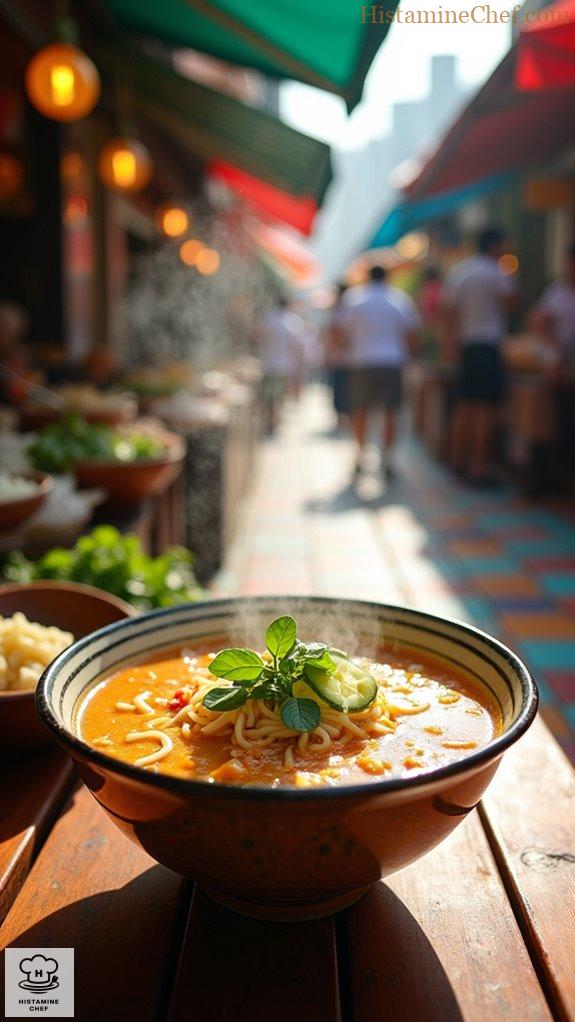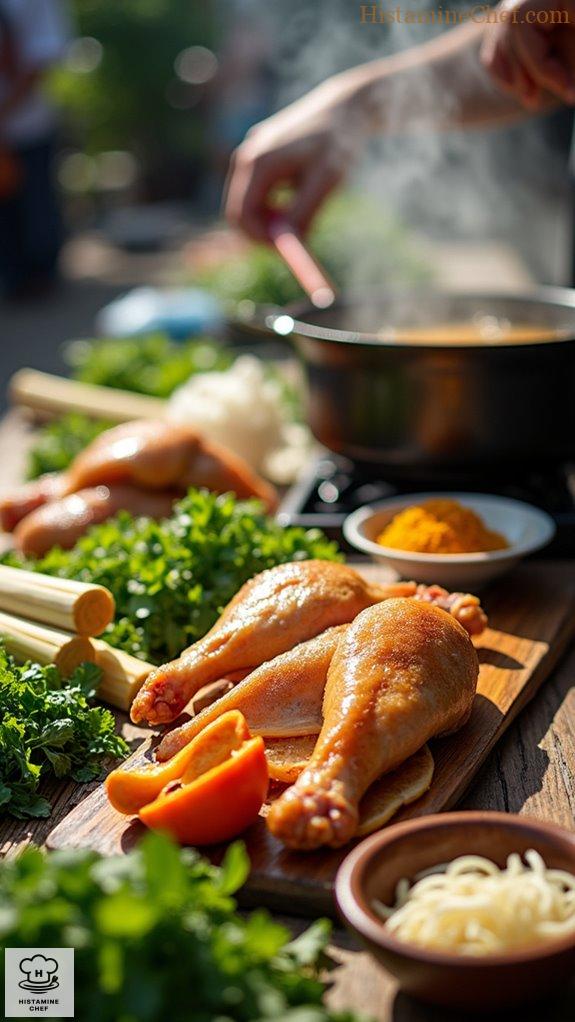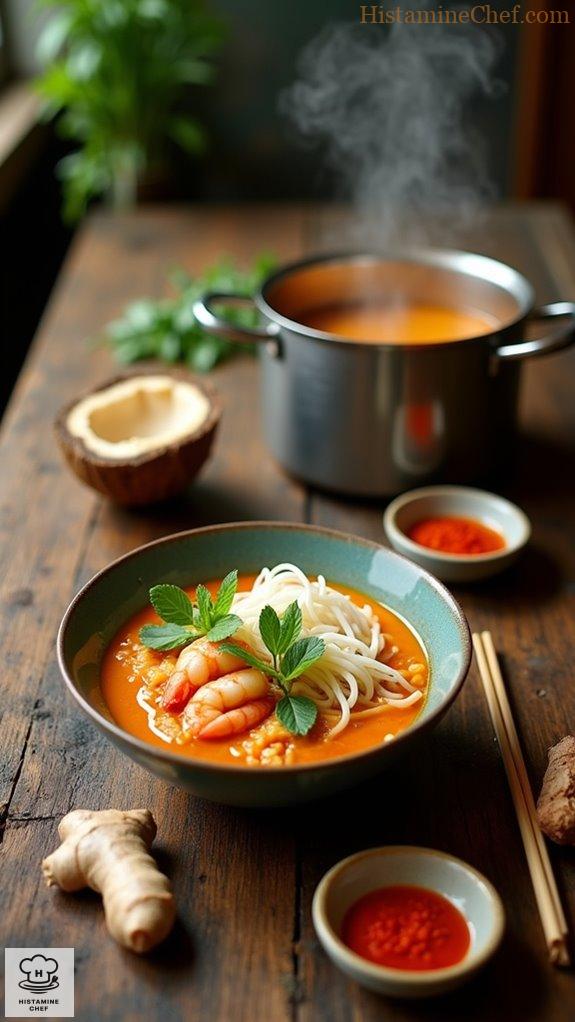If you’re craving Singapore laksa but want to keep it low histamine, I’ve got you! Start by simmering fresh chicken in a fragrant broth made with ginger, turmeric, and coconut milk—no processed junk here! Rinse some rice noodles and toss them in with bean sprouts for crunch. Did you know avoiding shrimp paste and high-histamine ingredients could make your tummy sing? Intrigued? Stick around, and I’ll guide you through each tasty twist!
Culinary Hub of Southeast Asia

Singapore, often hailed as the culinary hub of Southeast Asia, boasts a vibrant street food culture that reflects its rich multicultural heritage.
Originating from a melting pot of Malay, Chinese, Indian, and Peranakan influences, street food in Singapore has evolved over decades, becoming emblematic of the nation’s identity.
The tradition began in the early 20th century when hawkers set up stalls in public spaces, offering affordable and flavorful dishes to the working class.
Today, the iconic hawker centers are popular gathering spots, where locals and tourists alike indulge in a plethora of flavors, from fiery chili crab to the aromatic laksa, a signature dish that combines spicy coconut curry with noodles.
These bustling centers not only showcase the city’s culinary diversity but also serve as platforms for preserving traditional recipes and promoting community engagement.
As new generations of chefs emerge, the spirit of street food continues to thrive, ensuring that the rich history of Singapore’s culinary terrain remains a cherished part of the nation’s cultural tapestry.
Steaming Broth in Roadside Stalls

Street vendors in Singapore create their signature laksa broth by simmering a mix of fresh ingredients over a portable gas stove. The base typically includes simmering chicken or freshly caught fish, which adds depth and flavor to the broth.
Vendors continuously stir the liquid, combining lemongrass, galangal, and toasting spices like coriander and turmeric in a separate pan to release their aromas. Once the water is boiling, the spice mixture is poured into the broth, creating a fragrant, spicy foundation.
The broth is often topped with fresh herbs, an offering of bean sprouts, and noodles, which are blanched separately to guarantee they maintain their texture. The entire process is a synchronized dance, allowing for quick service while assuring each bowl is bursting with flavor.
Ingredients Needed:
- Chicken (500g, boneless)
- Fresh fish (250g, filleted)
- Rice noodles (200g)
- Lemongrass (2 stalks, chopped)
- Galangal (1 piece, sliced)
- Coriander powder (1 tsp)
- Turmeric powder (1 tsp)
- Bean sprouts (100g)
Cooking Steps:
- Boil water over gas stove.
- Add chicken and fish to water.
- Toast lemongrass and galangal until fragrant.
- Stir in coriander and turmeric.
- Pour spice mixture into broth.
- Blanch rice noodles in boiling water.
- Serve noodles in bowls with broth.
- Top with bean sprouts and herbs.
Homemade Version Using Fresh Ingredients

To make a homemade version of Singapore Laksa, start by preparing a fragrant broth with fresh ingredients.
Begin by sautéing ginger, garlic, and coriander roots in coconut oil until fragrant. Add in homemade laksa paste using allowed spices, and simmer it with coconut milk and water.
For protein, use fresh chicken or shrimp; cook them in the broth until tender.
Serve the broth over allowed rice noodles, adding fresh herbs like mint or coriander as garnish.
For an added twist, include allowed vegetables like bean sprouts or shredded carrots.
Avoid any high-histamine ingredients for the best results.
Cooking Steps or Ingredients Changed at Home:
- Use coconut oil for frying
- Make fresh laksa paste
- Include fresh chicken or shrimp
- Use allowed rice noodles
- Add fresh herbs as garnish
- Avoid high-histamine ingredients
- Serve with allowed vegetables
Low Histamine Variation of Laksa

Street food often contains ingredients that can be high in histamine and liberators, making it challenging for individuals with histamine intolerance to enjoy these cuisines without triggering reactions.
Many popular street food dishes, like Singapore Laksa, usually include fermented, aged, or preserved items which are prominently restricted in the SIGHI list.
Consuming street food like Laksa can be problematic for those with histamine intolerance due to the presence of high histamine ingredients such as dried seafood, processed meats, or certain spices.
These ingredients can cause reactions ranging from mild discomfort to severe symptoms, as many are classified as restricted on the SIGHI list.
Low Histamine Variation of Laksa – Cooking Instructions:
- Use fresh chicken or duck instead of dried or processed meats.
- Opt for a homemade broth instead of store-bought which may contain preservatives.
- Replace typical laksa paste with allowed spices like ginger and turmeric.
- Exclude high histamine ingredients such as shrimp paste and chilies.
- Utilize coconut milk instead of any processed or full-fat creams.
- Add allowed vegetables like carrots, zucchini, or broccoli instead of restricted ones.
- Use rice noodles instead of egg noodles or other wheat products.
- Avoid any sauces or products containing soy sauce or fermented ingredients.
- Season with allowable herbs such as cilantro or basil for freshness.
- Serve with fresh lime juice instead of the usual citrus fruits.
Video Summary
Singapore Laksa is a renowned noodle soup that blends Malay and Chinese culinary traditions. Today, we’ll explore the authentic street version and a home-friendly low histamine adaptation.
Street vendors start by boiling a fragrant broth with spices, shrimp paste, and fresh coconut milk. They create a rich laksa paste, mixing chili, garlic, and ginger in a mortar and pestle. Once the paste is ready, they sauté it in a large pot with coconut oil until aromatic.
Next, they add water and let the broth simmer for stirring in their perfectly cooked rice noodles. They then prepare toppings like fresh bean sprouts, boiled eggs, and shredded chicken for garnishing. Each bowl gets a generous spoonful of the luscious broth poured over the noodles, topped with herbs for a burst of flavor.
For our low histamine version, you’d start by replacing the shrimp paste with coconut milk for creaminess. Use fresh ginger and garlic instead of chili paste to enhance flavor gently.
You’ll then sauté this mix in coconut oil until aromatic. For noodles, opt for rice noodles and cook them as usual. Instead of bean sprouts, use fresh spinach, lightly steamed.
Boil egg yolks separately for garnish, avoiding the problematic egg whites. Finally, top your bowl with a sprinkle of fresh herbs like basil or cilantro for freshness.
The final meal is a warm, comforting bowl full of aromatic, creamy goodness. Click the link in the description for the full recipe!


Leave a Reply